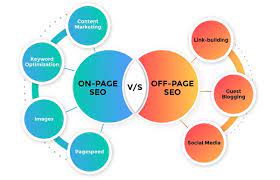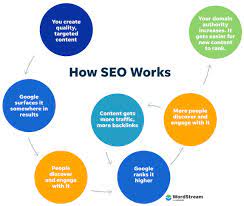SEO Content Writing: The Key to Unlocking Online Success
In today’s digital landscape, creating high-quality content is not enough. To truly succeed online, businesses need to master the art of SEO content writing. Search Engine Optimization (SEO) content writing involves crafting compelling and valuable content that not only resonates with your target audience but also ranks well in search engine results.
Why is SEO content writing so crucial? Well, search engines like Google use complex algorithms to determine which websites should be displayed on their search results pages. By optimizing your content for these algorithms, you can improve your website’s visibility and attract more organic traffic.
The first step in effective SEO content writing is conducting thorough keyword research. Keywords are the phrases or terms that users enter into search engines when looking for information. By identifying relevant keywords related to your business or industry, you can strategically incorporate them into your content.
However, it’s important to strike a balance between keyword optimization and user experience. Gone are the days when stuffing keywords into your content would guarantee higher rankings. Search engines now prioritize user intent and engagement. Your content should be informative, engaging, and provide value to your readers while naturally incorporating keywords.
Another essential aspect of SEO content writing is creating unique and original content. Duplicate or plagiarized content can harm your website’s rankings and reputation. Search engines value fresh and unique perspectives, so invest time in crafting original articles, blog posts, or product descriptions that set you apart from the competition.
Structuring your content properly is also vital for SEO success. Use headings (H1, H2, etc.) to break up your text and make it easier for both readers and search engines to navigate through the page. Incorporate bullet points or numbered lists to enhance readability.
Additionally, optimize your meta tags – title tags and meta descriptions – as they play a crucial role in attracting clicks from search engine users. A well-crafted title tag should accurately describe the content and include relevant keywords, while a compelling meta description can entice users to click on your link.
Link building is another aspect of SEO content writing that shouldn’t be overlooked. By including internal and external links within your content, you can improve your website’s authority and credibility. Internal links connect different pages on your website, while external links direct readers to reputable sources that support your content.
Lastly, regularly updating and refreshing your content is essential for maintaining its relevance. Search engines favor websites that provide up-to-date information. Consider revisiting older articles or blog posts to add new insights or statistics and keep them current.
In conclusion, SEO content writing is a powerful tool for businesses aiming to succeed online. By incorporating strategic keyword research, creating original and valuable content, optimizing structure and meta tags, building links, and keeping your content fresh, you can improve your website’s visibility in search engine results pages and attract more organic traffic. Invest in SEO content writing today and unlock the potential for online success.
5 Essential SEO Content Writing Tips for UK Businesses
- Use keywords strategically – Identify the most relevant keywords and phrases for your content, and use them throughout your text to improve search engine visibility.
- Keep it concise – Make sure your content is succinct and to the point, as lengthy content can be off-putting for readers.
- Include internal links – Linking to other pages on your website will help keep visitors engaged with your site for longer periods of time.
- Optimise page titles and meta descriptions – Ensure that all page titles are SEO-friendly and include relevant keywords, as well as crafting compelling meta descriptions that will encourage users to click through from search engine results pages (SERPs).
- Monitor analytics data – Regularly review analytics data such as bounce rates, average session duration or average page views per session in order to identify which pieces of content are performing best and adjust accordingly if needed.
Use keywords strategically – Identify the most relevant keywords and phrases for your content, and use them throughout your text to improve search engine visibility.
When it comes to SEO content writing, using keywords strategically is a fundamental practice that can significantly impact your website’s search engine visibility. Keywords are the words or phrases that users enter into search engines when looking for information, products, or services. By incorporating these keywords into your content in a natural and strategic manner, you can increase the chances of your website ranking higher in search engine results pages (SERPs).
The first step is conducting thorough keyword research to identify the most relevant and valuable terms for your business or industry. Put yourself in the shoes of your target audience and think about what they might search for when looking for information related to your offerings. There are various keyword research tools available that can help you discover popular and commonly used keywords.
Once you’ve identified the keywords, it’s important to use them strategically throughout your content. However, it’s crucial to strike a balance between keyword optimization and maintaining high-quality content that engages readers. Search engines now prioritize user intent and value, so simply stuffing keywords into your text will not yield positive results.
Incorporate keywords naturally within headings, subheadings, and throughout the body of your content. Aim for a keyword density of around 1-2% – meaning that the keyword should appear once or twice every hundred words. This ensures that search engines recognize the relevance of your content without compromising its readability and flow.
Additionally, consider using variations of your primary keyword throughout the text. This helps search engines understand the context of your content better while catering to different user queries. For example, if you’re targeting “best running shoes,” you can also include variations like “top-rated running shoes” or “high-performance trainers.”
Remember that SEO is an ongoing process, so monitor the performance of your chosen keywords regularly. Analyze how they impact organic traffic, click-through rates, and conversions. If certain keywords are not performing as expected, consider adjusting your strategy and exploring new keyword opportunities.
In summary, using keywords strategically is a vital aspect of SEO content writing. By identifying the most relevant keywords for your content and incorporating them naturally throughout your text, you can enhance your website’s visibility in search engine results. Keep in mind that providing valuable and engaging content to your audience should always be the primary focus, with keyword optimization serving as a tool to improve search engine rankings.
Keep it concise – Make sure your content is succinct and to the point, as lengthy content can be off-putting for readers.
The Power of Concise SEO Content Writing
In the world of SEO content writing, brevity is key. Keeping your content concise and to the point is essential for engaging readers and optimizing your search engine rankings.
Long gone are the days when lengthy articles were seen as a sign of authority. In today’s fast-paced digital era, readers have limited attention spans and seek information that is easily digestible. By crafting concise content, you can capture their interest and deliver your message effectively.
One of the main advantages of concise SEO content is its ability to hold readers’ attention. When faced with a wall of text, readers may feel overwhelmed or lose interest quickly. By presenting information in a clear and succinct manner, you can keep them engaged from start to finish.
Moreover, search engines also appreciate concise content. They value user experience and strive to provide the most relevant results for search queries. If your content is concise and answers users’ questions directly, search engines are more likely to rank it higher in their results pages.
To create concise SEO content, focus on delivering your message in a straightforward manner. Start with a compelling introduction that grabs readers’ attention and clearly states what they can expect from your article or blog post. Use short sentences and paragraphs to enhance readability.
Additionally, consider organizing your content using headings or subheadings to break up information into easily scannable sections. This allows readers to quickly find the specific details they are looking for without having to sift through lengthy paragraphs.
While being concise is important, it’s crucial not to sacrifice quality for brevity. Ensure that your content remains informative, valuable, and provides actionable insights for readers. Every word should serve a purpose and contribute to the overall message you want to convey.
Remember that different types of content may require different levels of detail. For example, product descriptions may need to be more succinct compared to in-depth guides or tutorials. Tailor your approach accordingly to meet the specific needs of your target audience.
In conclusion, concise SEO content writing is a powerful tool for engaging readers and optimizing your search engine rankings. By keeping your content succinct, you can capture and hold readers’ attention while delivering valuable information. Remember to focus on quality, use headings to enhance readability, and tailor your approach based on the type of content you are creating. Embrace the power of conciseness and watch your SEO efforts flourish.
Include internal links – Linking to other pages on your website will help keep visitors engaged with your site for longer periods of time.
Boost Engagement and SEO Success with Internal Links
When it comes to SEO content writing, one often overlooked yet powerful tip is to include internal links within your website. Internal linking refers to the practice of linking to other pages on your own site, creating a web of interconnected content. Not only does this help visitors navigate through your website more easily, but it also plays a crucial role in boosting engagement and improving your search engine rankings.
One of the key benefits of internal linking is that it keeps visitors engaged with your site for longer periods of time. By providing relevant and informative links within your content, you encourage users to explore additional pages on your website. This not only increases their overall time spent on your site but also reduces the bounce rate – the percentage of visitors who leave after viewing only one page.
Moreover, internal linking helps establish a logical and organized structure for your website. By interconnecting related pages, you create a pathway for users to navigate from one topic to another seamlessly. This enhances user experience and makes it easier for them to find the information they are looking for.
From an SEO perspective, internal links are valuable because they distribute link equity throughout your website. Link equity refers to the authority or ranking power that a webpage possesses. By strategically placing internal links from high-ranking pages to other relevant pages on your site, you pass on some of that authority and help those linked pages gain visibility in search engine results.
Internal linking also aids search engines in understanding the structure and hierarchy of your website. When search engine bots crawl through your site, they follow these links to discover new content and determine its relevance. By providing clear pathways through internal links, you ensure that all important pages on your site are discovered and indexed by search engines.
When implementing internal links, remember to use descriptive anchor text – the clickable text that leads users from one page to another. Anchor text should accurately describe the linked page’s content using relevant keywords whenever possible. This not only helps users understand where the link will take them but also provides additional context for search engines to understand the content being linked.
In conclusion, incorporating internal links in your SEO content writing strategy is a smart move to boost engagement and improve your website’s visibility. By keeping visitors engaged with your site for longer periods, creating a logical structure, distributing link equity, and aiding search engine crawlers in discovering your content, internal linking proves to be a valuable tool for both user experience and SEO success. So, start interconnecting your webpages today and reap the benefits of increased engagement and improved rankings.
Optimise page titles and meta descriptions – Ensure that all page titles are SEO-friendly and include relevant keywords, as well as crafting compelling meta descriptions that will encourage users to click through from search engine results pages (SERPs).
Optimise Page Titles and Meta Descriptions: The Key to Click-Worthy Content
When it comes to SEO content writing, one tip stands out as a game-changer: optimising page titles and meta descriptions. These two elements play a crucial role in attracting users to click through from search engine results pages (SERPs) and can significantly impact your website’s visibility and traffic.
Page titles are the first thing users see when scanning through search results. Crafting SEO-friendly page titles that include relevant keywords is essential for improving your website’s ranking in SERPs. Incorporating targeted keywords into your page titles not only helps search engines understand the content of your page but also signals its relevance to users.
However, it’s important to strike a balance between keyword optimization and creating compelling titles. While keywords are crucial, they should be used naturally and not at the expense of readability or user experience. Aim for concise, descriptive page titles that accurately represent the content while capturing attention.
Equally important are meta descriptions, which provide a brief summary of what users can expect when they click on your link. Crafting compelling meta descriptions is key to encouraging users to choose your website over others in the search results. A well-crafted meta description should be concise, engaging, and entice users with a clear call-to-action.
To optimise your meta descriptions effectively, focus on highlighting the unique value proposition of your content or offering. What sets you apart from competitors? Why should users click on your link? Answering these questions within the limited character count of a meta description can make all the difference in attracting clicks.
Remember that both page titles and meta descriptions should align with the actual content on your webpage. Misleading or irrelevant information will not only harm user experience but may also lead to higher bounce rates as visitors quickly leave if their expectations aren’t met.
Regularly reviewing and updating page titles and meta descriptions is essential as well. As search trends and user preferences evolve, it’s crucial to stay current and ensure that your titles and descriptions remain relevant. Continuously monitoring the performance of your pages in SERPs can help you identify opportunities for improvement.
In conclusion, optimising page titles and meta descriptions is a vital aspect of SEO content writing. By creating SEO-friendly page titles that incorporate relevant keywords and crafting compelling meta descriptions that entice users to click through, you can improve your website’s visibility in search results and attract more organic traffic. Invest time in honing these elements, and watch as your click-through rates soar.
Monitor analytics data – Regularly review analytics data such as bounce rates, average session duration or average page views per session in order to identify which pieces of content are performing best and adjust accordingly if needed.
Monitoring Analytics Data: A Key Element of Effective SEO Content Writing
When it comes to SEO content writing, one crucial tip that should never be overlooked is monitoring analytics data. By regularly reviewing important metrics such as bounce rates, average session duration, or average page views per session, you can gain valuable insights into the performance of your content and make necessary adjustments for optimal results.
Analytics data provides a wealth of information about how users interact with your website and its content. Bounce rate, for instance, indicates the percentage of visitors who leave your website after viewing only one page. A high bounce rate may suggest that the content is not engaging or relevant enough to retain visitors. By identifying pages with high bounce rates, you can analyze what might be going wrong and take steps to improve user experience or refine the content.
Average session duration measures the amount of time users spend on your website during a single visit. This metric reflects user engagement and interest in your content. If you find that certain pages have low average session durations, it may indicate that the content is not holding visitors’ attention or failing to provide the information they are seeking. By analyzing these pages more closely, you can identify areas for improvement and optimize them accordingly.
Another useful metric to monitor is average page views per session. This metric provides insights into how many pages users typically navigate through during a single visit to your website. Higher average page views per session generally indicate that users are exploring more of your content, finding value in it, and staying engaged. On the other hand, lower page views per session could suggest that users are not finding enough internal links or related content to continue their journey on your site.
By regularly reviewing these analytics metrics and comparing them across different pieces of content, you can identify which ones are performing best and which ones may need adjustment or improvement. It allows you to make data-driven decisions when optimizing your SEO content strategy.
Adjusting your approach based on analytics data is crucial for maintaining and improving the effectiveness of your content. It helps you understand what resonates with your audience, what needs improvement, and what strategies are delivering the desired results. With this valuable information in hand, you can refine your content, enhance user experience, and ultimately drive better organic traffic and conversions.
In conclusion, monitoring analytics data is an essential aspect of effective SEO content writing. By regularly reviewing metrics such as bounce rates, average session duration, and average page views per session, you can gain valuable insights into the performance of your content. This enables you to identify which pieces of content are performing best and make necessary adjustments to optimize user experience and achieve your SEO goals. Embrace the power of analytics data to enhance your SEO content strategy and drive online success.



